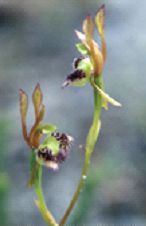Well, things are starting to happen in the orchid field, and it is exciting to see some more of our autumn orchid species appear.
Last month we mentioned that the Fringed Midge Orchid Corunastylis ciliata had not been seen, so it is good news that we have recently found over thirty of these attractive little orchids growing in an open grassy area. Although the flower stems are shorter than usual, they nevertheless carried up to ten, crowded, yellowish-green flowers with red tonings. The small red labellum has tiny hairs fringing its edges, and is upturned at the tip. This is a rare orchid and very difficult to notice amongst the grasses.

Fringed Midge Orchid
Fringed Hare Orchids Leporella fimbriata have also appeared in a number of places. The flowers are just so tiny – perhaps we should call them Leveret Orchids – but perfect in every way. With their two, erect greenish brown petals ending in reddish-brown, club-shaped tips resembling a hare’s ears, and a fringed labellum, they stand out amongst the grasses on the sides of the tracks, where they are often found.

Fringed Hare Orchid
Another species that has flowered well is the small Parson’s Band Orchid Eriochilus cucullatus. In fact, wherever I have been searching for orchids I have found this eye-catching flower scattered throughout the woodlands and grasslands. The flowers are delicately perfumed, and the honey fragrance attracts native bees. The two white lateral sepals are prominent, pointing downwards like the bands on a parson’s collar.

Parson’s Band Orchid
Flowers of Brown Tipped Greenhoods Pterostylis sp. aff. parviflora are just beginning to open, with their tiny flowers facing towards the stem. The petals and sepals have brownish tips, in contrast with the all green flowers of the Tiny Greenhood Pterosytylis parviflora, which I have not managed to locate as yet this year. The paired leaves of autumn Bird Orchids Chiloglottis reflexa are breaking through the soil, as well as rosettes of the widespread Nodding Greenhoods Pterostylis nutans. Hopefully, some long-awaited autumn rains will encourage more orchids to appear.
Please let us know of your orchid observations. We do appreciate the sharing of locations adding to the larger picture of orchids in the district.
All of these orchids are photographed and described in Orchids of the Anglesea District, available from Angair.
Margaret MacDonald